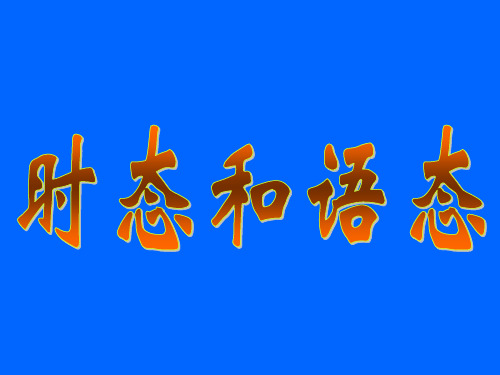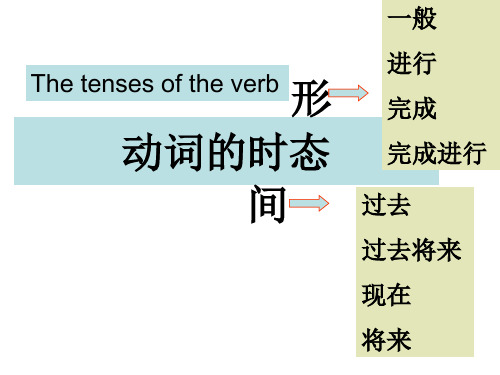英语动词时态语态PPT课件
合集下载
新东方动词时态语态PPT课件

2. 与现在相对比
I don't know. I didn't know.
..\片段节选\狮子王2didn't know.ra
I think. I thought.
..\片段节选\狮子王3thought.ra
I forget. I forgot.
..\片段节选\六人行1forgot.ra
(09,全国I)Edward, you play so well. But I ______ you played the piano.
Ice feels cold.冰摸上去凉。 His plan proved (to be) practical.
②表示开始、结束、运动的词:begin, finish,start,open,close,stop, shut等。 Class begins!开始上课。
Work began at 7 o’clock this morning.
1. 一般将来时 2. 将来进行时 3. 将来完成时
一般现在时
1. 现在发生的事情
现在??
2. 经常发生的动作或存在的状态
状态??
一般现在时
1. 规律情况而非具体一次 2. 现在时刻非具体性动作(能力,性 格,特征等) 3. 永恒真理或既定事实,无时间限制 4. 主将从现,主情从现
一般过去时 1. 过去发生的事(短暂,经常, 持续)
现在进行时
1. 正在进行的动作
2. 不断重复的动作(表情绪)
3. 与表示动作开始和结束的词 连用表将来
-Are you still busy? -Yes, I _____ my work, and it won't last long. A. just finish B. am just finishing C. have just finished D. am just going to finish
I don't know. I didn't know.
..\片段节选\狮子王2didn't know.ra
I think. I thought.
..\片段节选\狮子王3thought.ra
I forget. I forgot.
..\片段节选\六人行1forgot.ra
(09,全国I)Edward, you play so well. But I ______ you played the piano.
Ice feels cold.冰摸上去凉。 His plan proved (to be) practical.
②表示开始、结束、运动的词:begin, finish,start,open,close,stop, shut等。 Class begins!开始上课。
Work began at 7 o’clock this morning.
1. 一般将来时 2. 将来进行时 3. 将来完成时
一般现在时
1. 现在发生的事情
现在??
2. 经常发生的动作或存在的状态
状态??
一般现在时
1. 规律情况而非具体一次 2. 现在时刻非具体性动作(能力,性 格,特征等) 3. 永恒真理或既定事实,无时间限制 4. 主将从现,主情从现
一般过去时 1. 过去发生的事(短暂,经常, 持续)
现在进行时
1. 正在进行的动作
2. 不断重复的动作(表情绪)
3. 与表示动作开始和结束的词 连用表将来
-Are you still busy? -Yes, I _____ my work, and it won't last long. A. just finish B. am just finishing C. have just finished D. am just going to finish
高中英语语法时态和语态课件(共69张PPT)

不能用 be+v-ing, be+v-ing表示将来,主要强调已经 作出的 安排,e.g. i’m pic you up at 6:00,don’t forget. ) ②强调某个意图是事先考虑好的:
--ann is in hospital.
--yes, i know. i’m going to visit her tomorrow.
--oh,really? i didn’t know. i’ll go and visit her. 2〕表示迹象表明要发生某事,则只能用be going to,e.g.
look at the dark clouds.it’s going to rain. 3〕be going to还有以下用法,e.g. ①强调主观想法或意图: i’m going to wash the car if i have time. (注意:此时
②It was then a small fishing village.
2.特别用法:
1〕表客气或委婉的现在:
①I wondered if you were free this evening.
②I thought you might like some flowers.
(注:过去进行时也可表示现在使语气更委婉、客气,eg.① I was wondering if you could give me a lift. ②We were hoping you would stay with us.能这样用的动 词主要限于want, wonder , think, hope, intend等少数 动词。)
②Someone has broken the window.(结果: 窗户仍破 着)
2〕持续性用法:该用法表示一个过去发生的动作在过去 并未在过去完成,而是持续到现在,且可能继续持续下去 或可能到此结束,e.g.
--ann is in hospital.
--yes, i know. i’m going to visit her tomorrow.
--oh,really? i didn’t know. i’ll go and visit her. 2〕表示迹象表明要发生某事,则只能用be going to,e.g.
look at the dark clouds.it’s going to rain. 3〕be going to还有以下用法,e.g. ①强调主观想法或意图: i’m going to wash the car if i have time. (注意:此时
②It was then a small fishing village.
2.特别用法:
1〕表客气或委婉的现在:
①I wondered if you were free this evening.
②I thought you might like some flowers.
(注:过去进行时也可表示现在使语气更委婉、客气,eg.① I was wondering if you could give me a lift. ②We were hoping you would stay with us.能这样用的动 词主要限于want, wonder , think, hope, intend等少数 动词。)
②Someone has broken the window.(结果: 窗户仍破 着)
2〕持续性用法:该用法表示一个过去发生的动作在过去 并未在过去完成,而是持续到现在,且可能继续持续下去 或可能到此结束,e.g.
高中英语动词的时态、语态 课件

按词义和句中的作用,动词可以分为四类
类别
特点
意义
vt.及物+宾语 实义动词
须跟宾语一起才能表达 完整的意思
(vt. vi.) 不及物vi.不能直接+ 能独立作谓语 宾语
系动词 跟表语,(有词汇 不能独立做谓语,跟表 (link-v) 意义/状态,持续, 语构成完整意思
表象,感官,变化)
举例 I have a book..
(2)动词第三人称单数形式的变化规则:
构成
例词
一般在动词原形后加s run→runs like→likes
teach→teaches
以ch, sh, s, o, x结尾的动 wash→washes
词,加es
go→goes
pass→passes
以辅音字母加y结尾的动 study→studies 词,先将y变i再加es try→tries
动词的时态、语态
.(1)基本用法: ①表示经常性、习惯性的动作或存在的状态;常与表示 频度的时间状语 always,often,usually,sometimes, once a week,every day 等连用。 He always helps others. 他总是帮助别人。 练习:1,他天天洗头(wash his hair)。
finish 结束
fix 修理/固定
go 去
teach 教
wash洗
have有
say说
play玩
cry 哭
match适应/使相配 guess猜
study学习
carry运送/支撑
主语
第一人称:我、我们
第二人称:你、你们 第三人称:其他的一切
单数 复数
高三英语复习:时态语态课件(共10张PPT)

将来进行时 will/shall be doing will/shall be being done
现在完成时
过去完成时 现在完成进行
时
have/has done had done
have/has been done had been done
have/has been doing
• 不同时态变被动的规律总结:
(2)结尾是s, x, sh, ch, o,前为辅音字母,结尾加es :
• watch— ___________ teach—___________
• go— ___________
do— __________
• wash— ___________
cross— ___________
• mix— __________
at a young age, during the trip, on my previous visits, on April 4, 2016, last night, at the last minute, 表示过 去一段时间内经常发生的或习惯性的动作 第44题 其他根据并列动词时态
固定句式: since 句式 第32,38,40,共3题。 被动语态: 第33,34,35,36,37,41,54,共7题。 不规则动词: 第30,32,33,44,54,共5题
• 保留原来时态中助(will/shall/would/am/is/ are/was/were/has/have/had),把be动词变 为原来时态中do的形式,再加动词的过去分词。
对动词时态语态考察形式的总结:
• 一般现在时:1-14题 • (1)表示现在的状态或经常、反复、习惯性的
动作。 第3题,共1题 (2)表示客观事实或普遍真理。 第1,2,5,6,14,共5题 (3)主将从现 第4,9,10,11,12,13,共5题
初中英语动词的时态和被动语态(共14张PPT)

延续性动词 be on be at/in+地点 be at/in+地点 be in/a member of be on have know keep
have a cold
have been to—have gone to
曾经去过(主语人在) 已经去了(主语人不在)
--I can’t find you these days.Where have you been?
be over be up be back be away (from) be here /there
非延续性动词 put on come/go to arrive/reach/get to join begin/start buy get to know borrow / lend
catch a cold
定义 表示过去某时间或某动作以前发生的动作。
结构 关健字
S+had+V过去分词
IwSr+heheaanlidzIner’det+aIVchh过ae去dd分let词hftemcoyupHnutar.sde+Sa+t Vh过om去分e词
by the time I came back,by the end of last term, when I got to the station,before he went to bed
表示过去某时刻或某阶段正在发生的动作。
was
1.SW+hawtawsna’st /hwe edroein’gt dwohinegn the UFO arrived?
结构 S+ weredoing 2W. Tahse/yWweerree+hSav+idnoginfugn…th?ese days.
动词PPT课件

被动语态的构成
be动词+动词的过去分词 。例如:The book was written by him.(这本书 是他写的。)
03
动词不定式与动名词
不定式概念及形式
概念
不定式是动词的一种非谓语形式,表 示一种未完成的或将来的动作,由 “to + 动词原形”构成。
形式
不定式有一般式(to do)、完成式( to have done)和进行式(to be doing)三种形式,分别表示不同的 时间概念。
情态动词没有人称和数的变化 ,但有些情态动词有过去式的 变化。
can/could, may/might, must等情态动词用法
can/could 表示能力、可能性、允许或请求。例如
I can swim.(我会游泳。)Could you help me?(你能帮我吗?)
may/might 表示允许、可能或祝愿。例如
虚拟语气是一种特殊的动词形式,用来表示说话人的主观愿望、假设或建议等,而不是客观 事实。
虚拟语气的基本形式包括与现在事实相反的虚拟、与过去事实相反的虚拟和与将来事实相反 的虚拟。
虚拟语气的形式包括基本形式和倒装形式,其中倒装形式用于省略if的条件句中。例如:If I were you, I would go.(如果我是你,我会去的。)Had you come yesterday, you would have seen him.(如果你昨天来的话,你就会见到他了。)
walked to school yesterday.( 她昨天步行去学校。)
将来时
表示将来某个时间将要发生的动 作或存在的状态。例如:They will visit their grandparents next week.(他们下周将去看望
动词的时态和语态-PPT课件

8. The man _h_a_d__h_o_p_e_d__ (hope) to catch the last train, but he was too late.
9. The boys __w_e_r_e_p_l_a_y_in_g___ (play) basketball from 5:00 to 6:00 yesterday.Βιβλιοθήκη .19练习
.
20
用所给动词的正确形式填空: 1. She _l_e_ft__ (leave) the office two
hours ago. 2. As son as she arrived home, the girl
discovered that she _h_a_d__t_a_k_e_n__ (take) her friends book by mistake. 3. Who _c_o_m__e_s__ (come) to school earliest in your class every morning? 4. Great changes _h_a_v_e_t_a_k_e_n_p__la_c_e__ (take place) in this city since 1979. 5. By the time he was twelve, Edison _h_a_d__b_e_g_u_n_ (begin.) to sell newspape21rs.
I’ll go to see you when I have time. I’ll go to see you if I have time tomorrow. 2. 某些动词,如:stand, continue, wish, love, like, hate, feel, find, think等常用一般现在时态
9. The boys __w_e_r_e_p_l_a_y_in_g___ (play) basketball from 5:00 to 6:00 yesterday.Βιβλιοθήκη .19练习
.
20
用所给动词的正确形式填空: 1. She _l_e_ft__ (leave) the office two
hours ago. 2. As son as she arrived home, the girl
discovered that she _h_a_d__t_a_k_e_n__ (take) her friends book by mistake. 3. Who _c_o_m__e_s__ (come) to school earliest in your class every morning? 4. Great changes _h_a_v_e_t_a_k_e_n_p__la_c_e__ (take place) in this city since 1979. 5. By the time he was twelve, Edison _h_a_d__b_e_g_u_n_ (begin.) to sell newspape21rs.
I’ll go to see you when I have time. I’ll go to see you if I have time tomorrow. 2. 某些动词,如:stand, continue, wish, love, like, hate, feel, find, think等常用一般现在时态
中考英语总复习 专题10 动词的时态和语态课件

归纳现在进行时的构成
主语+am/is/are+动词-ing形式
现在进行时的用法
1.表示(biǎoshì)现在(指说话人说话时)正在发生的事情。如: We are waiting for you. 我们正在等你。 2.表示当前一段时间内的活动或现阶段正在进行的动作。如: Mr.Green is writing another novel these days.
A.takes B.took
C.will take D.has taken
第五页,共二十三页。
归纳一般过去时的构成
主语+was/were/did+其他 一般过去时的用法 (1)表示过去某个时间或某一段时间内发生的动作或存在(cúnzài)的状 态。常见的时间状语有:yesterday,last week,an hour ago,the other day,in 1982等。如: Where did you go just now?
您还要些什么吗?
I wondered if you could help me. 我在想你能不能帮我一下。
②情态动词 could,would。如:
Could you lend me your bike? 你的自行车能借我用一下吗?
第七页,共二十三页。
(三)现在(xiànzài)进行时
第八页,共二十三页。
(一)常考的被动语态
A.Invites
C.was invited
B.is invited
D.has invited
第十八页,共二十三页。
2.(2017—2018学年(xuénián)安徽合肥蜀山50中西区第三次月考)If more salt
C to the soup,it will taste better. A.will add B.adds C.is added D.will be added 3.(2018·安徽合肥庐阳区二模,44)All the people I have known in the past three
中考英语(人教版)动词的时态和语态 (共114张PPT)

考点二 一般过去时 1.概念、句式结构及常用的时间状语 (1)概念:一般过去时表示过去某个时间所发生的动作 或存在的状态。
(2)句式结构(肯定句)有以下四种:
句式结构
例句
was/were+表语 She was a beautiful girl ten years ago. Her father was on business.
句式结构
例句
am/is/are+表语
She is a beautiful girl. Her father is always on business.
there is/are
There is a schoolbag on the desk. There are five people in my family.
(3)常用的时间状语有:yesterday(昨天), the day before yesterday(前天), last week(上星期), last month(上个月), last year(去年), two days ago(两天前), three years ago(三年 前), in 2001(在 2001 年), just now(刚才)等。
(3)描述客观真理、客观存在或科学事实等。 The light travels faster than the sound. 光比声音传播得快。 The sun rises in the east.太阳从东方升起。
注意 在宾语从句中,即使主句是一般过去时,但 从句表示客观真理、客观存在或科学事实时,从句依然用 一般现在时。
(根据汉语意思完成句子。) 如果我找到他的电话号码,我会告诉你。 If I find his phone number, I will tell you.
- 1、下载文档前请自行甄别文档内容的完整性,平台不提供额外的编辑、内容补充、找答案等附加服务。
- 2、"仅部分预览"的文档,不可在线预览部分如存在完整性等问题,可反馈申请退款(可完整预览的文档不适用该条件!)。
- 3、如文档侵犯您的权益,请联系客服反馈,我们会尽快为您处理(人工客服工作时间:9:00-18:30)。
( using 3 sentences or more,使用实意动词 和系动词, 注意动词形式变化)
2021/3/12
5
一、 一般现在时 (The Simple Present tense )
1. 结构: do/does
2. 用法: 1) 经常性或习惯性的动作,常与表示频 率的时间状语连用,如often, usually, always, every day/year, sometimes, on Sunday等。
• He said he would go for a holiday when he finished his work.
2021/3/12
10
• picture
犹如
导入之三:How will you spend your winter holiday? I will… I’m going to…
6
3)汽车、飞机、会议等按时刻表将要发生的事。 The train leaves at three this afternoon.
The meeting starts at 2:00 p.m.
4)在时间、条件、方式、让步状语从句中,用一 般现在时代替一般将来时,即主将从现。 If it _i_s_ (be) fine tomorrow ,we _w__il_l _g_o_ (go) to the countryside.
① ----The telephone is ringing. ----I _____ answer it.
√A. will B. am going to C. am to D. am about to
② ---Alice, why didn’t you come yesterday?
√ ---I _____, but I had an unexpected visitor.
English Basic Tenses (时都来。 He comes every day. 他昨天来了. He came yesterday. 他已经来了. He has come. 他明天来. He will come tomorrow.
汉语借助词汇手段而非词的形态变化来 表示动作的发生,而英语主要通过谓语动词 时态变化来表现.任何句子都要先注意时态.
2021/3/12
8
二、一般过去时 ( The Simple Past Tense )
1. 结构: 谓动用动词过去式 (V-ed)
2. 用法: 在过去时间里所发生的动作或存 在的状态。常与表示过去时间的时间状 语连用。如 yesterday, last week, an hour ago, in 1982等。
2021/3/12
9
examples:
• He was in Beijing some years ago.
• She traveled in Europe last year.
• When I was at collage, I wrote home once a week.
• He wet to town ,bought some books and visited his daughter last Sunday.
2021/3/12
11
三. 一般将来时
.表示将来时的四种形式 ① will / shall + 动词原形 ② be going to do ③ be about to do ④ be to do
2021/3/12
12
be going to 有很强的计划性,打算干什么,而will表 示谈话时临时决定的意图,具有临时性和偶然性。
2021/3/12
2
时态
语态
主动
一般现在时 一般过去时
v. / v-s/es V-ed
一般将来时 .will + v
过去将来时 would + v.
现在完成时 过去完成时
have / has + done had + done
现在进行时 am /is / are + V-ing
过去进行时 was / were + V-ing
20现21/3/在12 完成进行时 have/has been+ V-ing 3
语态 时态
将来进行时 将来完成时
主动
will be doing will have done
2021/3/12
4
导入之一:How is your daily life as a high school student?
I study hard every day and I get along well with my classmates, but sometimes I miss my families.
2)表示不受时间限制的科学事实或客观真理。
T2h021e/3/1e2 arth moves around the sun.
If he _c_o_m_e_s_ (come) this afternoon, we__w_i_ll_h_a_v_e__ (have) a meeting.
2021/3/12
7
导入之二:How did you spend your childhood?
Example:
I _s_p_e_n_t__ (spend) my childhood happily
A. had B. would C. was going to D. did
be going to 可用来表达某种迹象要发生的事。 而will 不能表示
Look at the clouds! It _i_s_g_o_i_n_g_t_o_ rain.
2021/3/12
13
3. be to 表示因约定、计划,职责、义务 要求即将发生的动作, 或客观安排或受 人指示而做某事。
with my old friends. We always
__p_la_y_e_d__(play) football and basketball
together and we __d_id__n_’t_ (not) have so
much homework to do as now. We
__w_e_r_e__ (be) happy at that time.
2021/3/12
5
一、 一般现在时 (The Simple Present tense )
1. 结构: do/does
2. 用法: 1) 经常性或习惯性的动作,常与表示频 率的时间状语连用,如often, usually, always, every day/year, sometimes, on Sunday等。
• He said he would go for a holiday when he finished his work.
2021/3/12
10
• picture
犹如
导入之三:How will you spend your winter holiday? I will… I’m going to…
6
3)汽车、飞机、会议等按时刻表将要发生的事。 The train leaves at three this afternoon.
The meeting starts at 2:00 p.m.
4)在时间、条件、方式、让步状语从句中,用一 般现在时代替一般将来时,即主将从现。 If it _i_s_ (be) fine tomorrow ,we _w__il_l _g_o_ (go) to the countryside.
① ----The telephone is ringing. ----I _____ answer it.
√A. will B. am going to C. am to D. am about to
② ---Alice, why didn’t you come yesterday?
√ ---I _____, but I had an unexpected visitor.
English Basic Tenses (时都来。 He comes every day. 他昨天来了. He came yesterday. 他已经来了. He has come. 他明天来. He will come tomorrow.
汉语借助词汇手段而非词的形态变化来 表示动作的发生,而英语主要通过谓语动词 时态变化来表现.任何句子都要先注意时态.
2021/3/12
8
二、一般过去时 ( The Simple Past Tense )
1. 结构: 谓动用动词过去式 (V-ed)
2. 用法: 在过去时间里所发生的动作或存 在的状态。常与表示过去时间的时间状 语连用。如 yesterday, last week, an hour ago, in 1982等。
2021/3/12
9
examples:
• He was in Beijing some years ago.
• She traveled in Europe last year.
• When I was at collage, I wrote home once a week.
• He wet to town ,bought some books and visited his daughter last Sunday.
2021/3/12
11
三. 一般将来时
.表示将来时的四种形式 ① will / shall + 动词原形 ② be going to do ③ be about to do ④ be to do
2021/3/12
12
be going to 有很强的计划性,打算干什么,而will表 示谈话时临时决定的意图,具有临时性和偶然性。
2021/3/12
2
时态
语态
主动
一般现在时 一般过去时
v. / v-s/es V-ed
一般将来时 .will + v
过去将来时 would + v.
现在完成时 过去完成时
have / has + done had + done
现在进行时 am /is / are + V-ing
过去进行时 was / were + V-ing
20现21/3/在12 完成进行时 have/has been+ V-ing 3
语态 时态
将来进行时 将来完成时
主动
will be doing will have done
2021/3/12
4
导入之一:How is your daily life as a high school student?
I study hard every day and I get along well with my classmates, but sometimes I miss my families.
2)表示不受时间限制的科学事实或客观真理。
T2h021e/3/1e2 arth moves around the sun.
If he _c_o_m_e_s_ (come) this afternoon, we__w_i_ll_h_a_v_e__ (have) a meeting.
2021/3/12
7
导入之二:How did you spend your childhood?
Example:
I _s_p_e_n_t__ (spend) my childhood happily
A. had B. would C. was going to D. did
be going to 可用来表达某种迹象要发生的事。 而will 不能表示
Look at the clouds! It _i_s_g_o_i_n_g_t_o_ rain.
2021/3/12
13
3. be to 表示因约定、计划,职责、义务 要求即将发生的动作, 或客观安排或受 人指示而做某事。
with my old friends. We always
__p_la_y_e_d__(play) football and basketball
together and we __d_id__n_’t_ (not) have so
much homework to do as now. We
__w_e_r_e__ (be) happy at that time.
